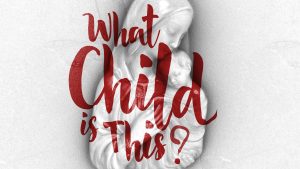
So much of our Christmas season focuses on the birth of Jesus, but we cannot look at the birth of Jesus without looking at the reason why Jesus came to live amongst us.
Luke’s Gospel tells the narrative of how Jesus would be conceived and named. In Luke 1:26-35 we read how Mary had an encounter with the angel Gabriel, and he told her that the baby would be called Jesus. Jesus means God Saves, this must have been another indicator to Mary of who Jesus really was.
Every child carries some of the attributes and characteristics of their mother and their father. The angel told Mary that Jesus would be conceived by the power of the Holy Spirit. Jesus would have some of the attributes of Mary and some of the attributes of God himself. And we know from Hebrews 1:3 that Jesus is fully God and fully man.
Jesus said to his disciples in John 14 verse 9, “Anyone who has seen me has seen the Father.”
So, this child, conceived miraculously by the power of the Holy Spirit, is the exact representation of God the Father and he is fully God, but by being born of Mary, he also has some of the nature of Mary. This is by God’s infinite design so that by being a man, Jesus would one day be able to offer himself as the perfect sacrifice for our sins.
The Apostle Paul wrote about this in Philippians 2:6-8.
We know that Jesus reflected the nature and character of God the Father, but how much of the character of Mary did Jesus possess as he walked the earth?
Looking at the way in which Jesus dealt with people we can see some of what Mary must have been like. Jesus was compassionate and kind, especially with children Jesus displayed patience and tenderness.
Jesus sought out the people on the fringes of society, calling them, showing them compassion and embracing them.
When the angel encountered Mary, he told her in verse 30, that she had found favor with God. God saw in Mary something special, she found favor with God possibly because she displayed the characteristics of gentleness, compassion, patience and tenderness. Perhaps it is possible that God saw in Mary the character traits, that He placed in her in the first place, but the character traits that would be necessary for Jesus to be who he was.
This child that lay asleep on her lap would one day grow up to have the character traits of care and compassion that his mother had.
There are several times in the Bible where the nature of God is described using motherly language and imagery (See Isaiah 66:13, Deuteronomy 32:11-12a, Psalm 22:9-10, Hosea 13:8a, Luke 13:34).
We see these images of God in the Bible as partial descriptions of the nature and character of God. Jesus is the exact representation of God; therefore, he must have these attributes himself. The same attributes that Mary displayed.
In addition to these characteristics, Mary and Jesus both displayed strong character in their lives. They both displayed great faith and trust in God. They were both willing and committed to the mission that God the Father had called them too. When Mary received the instructions from the Angel, her response was in Luke 1:38, “I am the Lord’s servant,” Mary answered. “May your word to me be fulfilled.”
When the time came for Jesus to face the completion of his mission, just before he was arrested and crucified, he prayed in the Garden of Gethsemane, humbly submitting to the perfect plan and will of the Father (Luke 22:41-42).
Both Jesus and Mary lived lives of extraordinary consequence, but both suffered deep pain. We only have a glimpse from the account of the crucifixion of how much pain and suffering Jesus went through as he paid the price for our salvation, but Mary also suffered. When Mary and Joseph took Jesus to the temple they met Simeon who praised God for allowing him to see the Messiah before his death, and went on to prophecy over Mary foretelling of the pain that she would one day endure (Luke 2:34-35).
Even in the Christmas carol, focusing on the birth of Jesus, we read of the purpose of why Jesus came to earth and gave up his glory in heaven. Mary was present at the crucifixion, standing by the cross, and enduring the agony of seeing her son die in the most excruciating way. Mary never left the side of Jesus, she was committed to being there for her son. This is also a promise of Jesus and one of the primary characteristics of the nature of God, he is a faithful God who promises to never leave us.
No matter how dark the season is that you are going through, no matter how lonely you feel at this Christmas season God is always near and his Word promises that He will be with you.
Jesus promised his disciples when he left them his Great Commission (Matthew 28:20b).
One of the most powerful scenes of compassion took place as Jesus hung suffering on the cross. Mary was there, and she wanted to help alleviate the pain, but Jesus looked at her and cared for her as he instructed the Apostle John to care for his mother (see John 19:26-17). What an incredible picture of love and compassion, in his pain he made sure that Mary was going to be taken care of.
“What child is this?” He is the one who came to love and to be the selfless sacrifice for all those who would believe in his name. But praise God, it didn’t end there. Jesus rose from the dead in a new resurrected body, Jesus became the first born of the new creation, and by his re-birth we can be born again.
Mary came to understand that this miraculous baby became the greater miracle, the way of salvation for millions of people who would put their faith and trust in him.
This Jesus is still the same today, full of compassion and love, ready to meet your needs.
If you are facing a huge trial and difficulty, Jesus knows what you are going through and he can meet your need.
If you are lonely and struggling with depression, Jesus knows your pain and is full of compassion.
Jesus came to earth as a little baby, to be fully man, so that he could identify with you and me (see Hebrews 4:15-16).

